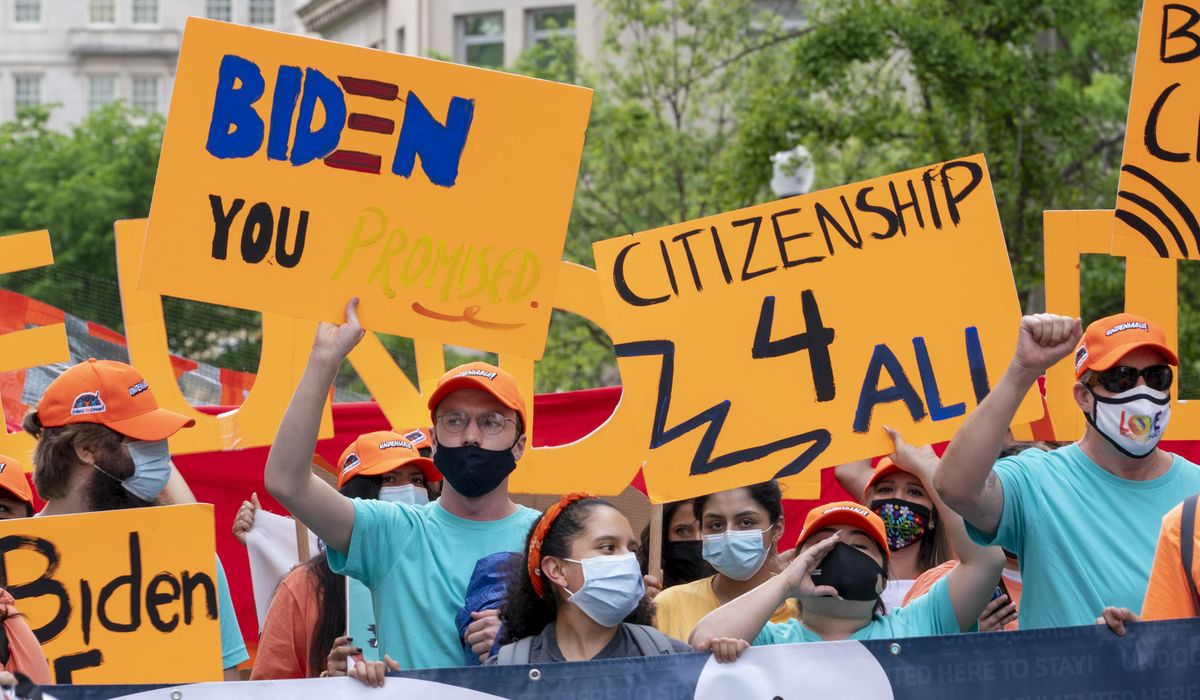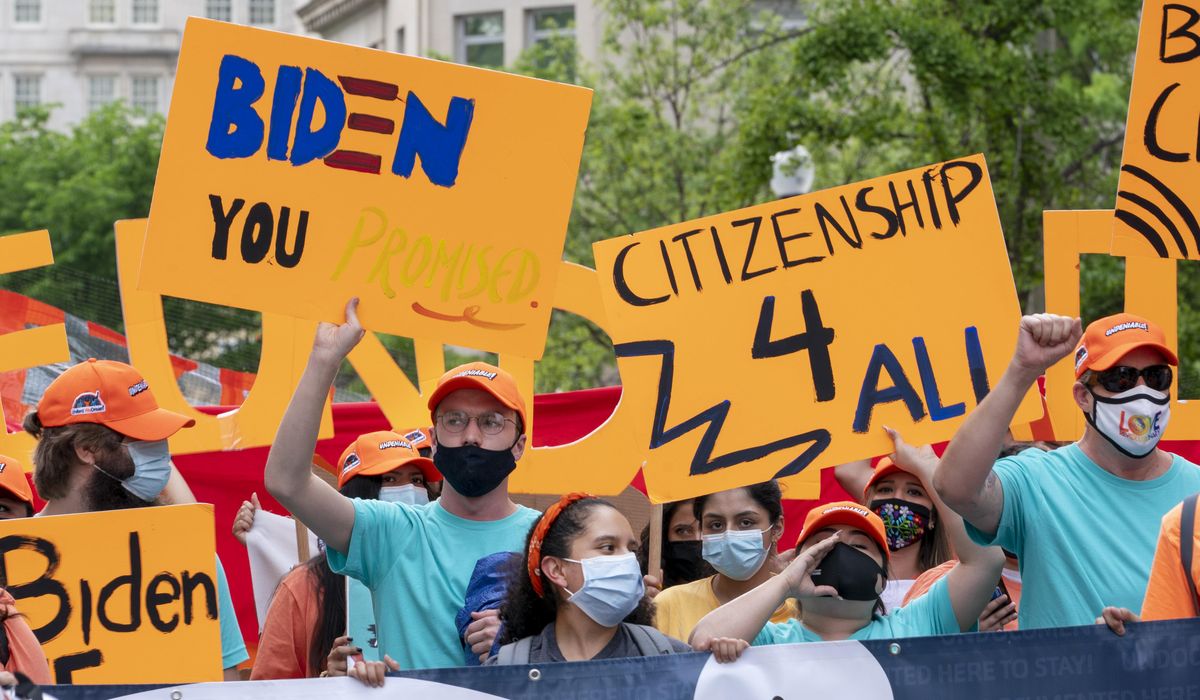
Forget drugs or fraud. The most common type of case federal prosecutors bring is against illegal immigrants who try to reenter the country after having been ousted — and almost all of those charged are Hispanic.
Now federal courts are grappling with whether that imbalance means the law itself is racist.
One court in Nevada has already ruled that it does. Judge Miranda Du, a President Obama appointee, said the section of law that makes it a felony for someone previously ousted to sneak back into the U.S. has racist antecedents dating to the 1920s.
Though the law has been updated since then, Congress has never “confronted the racist, nativist roots” of the law, the judge ruled. She said that, coupled with the overwhelmingly Hispanic targets for prosecution, makes the law unconstitutional.
She tossed the government’s case against Gustavo Carrillo-Lopez.
The Biden administration has appealed and the 9th U.S. Circuit Court of Appeals is hearing the case, which has reverberated across the legal world and is shaping up as a significant test of the critical race theory’s approach to criminal law.
“If we are trying to uproot systemic racism, that means we have to consciously understand what motivated a law’s original enactment, and then make the conscious decision whether we want to change it or whether we want to continue it,” Ahilan Arulanantham, co-director of the Immigration Law and Policy Center at UCLA School of Law and one of the leading scholars on the history of the illegal-reentry law, told The Washington Times in an interview earlier this year.
The illegal reentry law, Section 1326 of Title VIII of the U.S. Code, governs “reentry of removed aliens.”
Those guilty of the basic offense can be sentenced to two years in prison. If they had a drug record or a basic felony on their criminal record they could earn 10 years, and if they had an aggravated felony record they could get up to 20 years.
Usually, sentences are much shorter, but the law has serious teeth — and a lot of targets.
Disparate impact
According to a report last month by the Bureau of Justice Statistics, there were 30,636 prosecutions in fiscal year 2018 under Section 1326. That’s more than 36% of all federal prosecutions. Drug trafficking, the second most common, only accounted for half that many.
The BJS study doesn’t give an exact racial breakdown for Section 1326 prosecutions, but it does say 98% of all illegal immigrants prosecuted in 2018 were Hispanic, so it’s a good bet almost all Section 1326 cases were Hispanic.
The study was published after Judge Du‘s ruling, but she pointed to the overwhelmingly Hispanic demographics of those arrested jumping the border as evidence that “Mexican and Latinx individuals” are disproportionately affected by the illegal reentry law.
She said that, coupled with the fact that illegal reentry was first criminalized by Congress in 1929, by lawmakers who were influenced by the Jim Crow era of racial segregation and were looking to tamp down on Mexican migration.
Section 1326 itself was written in 1952 — again with arguably discriminatory intent, Judge Du concluded — and its penalties were stiffened in 1988, 1990, 1994 and 1996.
The judge said those Congresses never explicitly came to terms with the racist antecedents.
Kris Kobach, former secretary of state in Kansas and a prominent legal figure among groups who want stricter immigration, was stunned by the ruling.
“The judge’s conclusions are ridiculous,” he said. “The law is neutral on its face, and it is justified by a multitude of legitimate reasons having nothing to do with race. It is nonsense to declare that the statute must be ‘cleansed’ in some way because an unknown number of legislators who supported a predecessor statute a century ago might have been racially biased,” he said.
The Justice Department, in its appeal briefs, said Judge Du‘s math equating the high number of Latinos to racial discrimination ignored “the obvious alternative explanation that those numbers are attributable to geography and the high percentage of such individuals among the population of noncitizens unlawfully in the United States.”
Or, as Christopher J. Hajec at the Immigration Reform Law Institute put it to The Times earlier this year, when you border Mexico, and just south of that is Central America, you’re going to see a lot more illegal immigrants from those places trying to sneak back in.
“When you’re doing disparate impact you have to compare things with the right things. In the universe of illegal aliens a very large proportion are from Latin America, and that’s due to geography and economics,” Mr. Hajec said. “It follows that a large proportion of illegal entrants who’ve already been deported are going to be from Latin America, are going to be Hispanic.”
IRLI said the point of the law is to deter deported migrants from trying to come back, no matter where they’re from.
The case has forged odd alliances, with IRLI finding itself on the same side as the Biden administration.
Indeed, Homeland Security Secretary Alejandro Mayorkas earlier this year told employees at U.S. Immigration and Customs Enforcement that he thought there should be more prosecutions under Section 1326.
“I see cases now where we apprehend and remove individuals that I think need to be prosecuted criminally,” he told employees during a virtual town hall this spring. He said he would work with the Justice Department to try to bring more cases.
But Mr. Arulanantham says there must be some reckoning of the law’s history, and pointed to his own experience serving for two years as an assistant federal public defender in El Paso.
He figures he handled maybe 150 illegal reentry cases, yet he didn’t know the law’s origins at the time.
“That’s how systemic racism works, it’s nobody’s fault, but we live in a system and unless you’re very consciously able to examine it, you just go along with it,” he said.
Criminal vs. civil
Carrillo-Lopez, the man at the heart of the Nevada case, was already deported twice, with the most recent expulsion coming in 2012. He snuck back in at an “unknown time,” and was living secretly in the U.S. — Nevada lists a dozen different aliases he’s used — until he was caught on state drug-trafficking charges in 2019.
He also has a prior felony conviction for drugs and a misdemeanor domestic-violence conviction.
Even if he beats the federal illegal reentry charges, he’s not going to be out on the streets soon. He’s serving a life sentence on the drug trafficking charge, with no possibility of parole until 2029.
So far, this appears to be the only case where a judge has tossed the charges over questions about Section 1326. But if Judge Du‘s ruling stands, he wouldn’t be the last.
That would leave a couple options.
Congress could go back and repass the illegal reentry law, or something like it, this time grappling with the history and concluding that whatever the motives of the past, there’s a good reason today to have a criminal bar on deported people sneaking back into the country.
But it’s not clear that Congress would pass such a law again at this time, which opponents say is part of the whole point of performing a systemic racism analysis on the legal code.
“Forcing Congress to reenact this statute would be a significant legislative undertaking, particularly when it played a huge role in family separation,” Mr. Arulanantham said.
The other option is to live without a criminal penalty, and rely on the civil code and its penalty — another deportation.
Even those who are convicted under Section 1326 and serve time — about six months, according to the new Justice Department report — will usually be deported at the end of it anyway, which raises questions about whether the criminal law is needed as a deterrent.
But there are other implications to a world where laws like Section 1326 are ruled unconstitutional because of racist intentions by Congress at the time.
One target could be gun control laws, such as the Gun Control Act of 1968, which imposed a ban on sale of firearms to felons and created the first federal bar on explosives.
Scholars have argued that law was part of a push to keep firearms out of the hands of the country’s Black residents.








